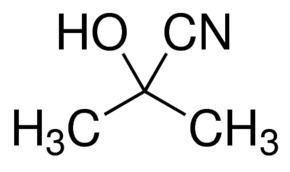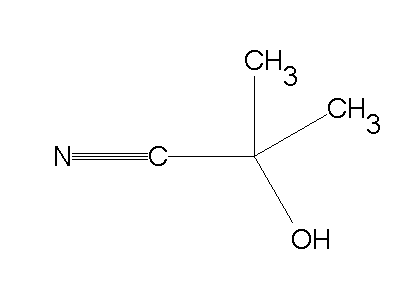3DMet B00479 Related compounds Density 932 kg/m³ Boiling point 95 °C | Appearance Colourless liquid Formula C4H7NO Molar mass 85.105 g/mol | |
 | ||
Related alkanenitriles | ||
Acetone cyanohydrin (ACH) is an organic compound used in the production of methyl methacrylate, the monomer of the transparent plastic polymethyl methacrylate (PMMA), also known as acrylic. It is extremely toxic.
Contents
Preparation

The compound is generated as part of the acetone cyanohydrin route to methyl methacrylate. It is treated with sulfuric acid to give the sulfate ester of the methacrylamide, methanolysis of which gives ammonium bisulfate and MMA. In the laboratory, this compound may be prepared by reacting sodium cyanide with acetone, followed by acidification:

Considering the high toxicity of acetone cyanohydrin, a safer lab scale production has been developed using microreactor technology. Alternatively, a simplified procedure involves the action of sodium or potassium cyanide on the sodium bisulfite adduct of acetone prepared in situ. This gives a less pure product that is suitable for most syntheses.
Natural occurrence

Cassava tubers contain linamarin, a glucoside of acetohydrin, and the enzyme linamarinase for hydrolysing the glucoside. Crushing the tubers releases these compounds and produces acetone cyanohydrin.
Safety

Acetone cyanohydrin is classified as an extremely hazardous substance in the US Emergency Planning and Community Right-to-Know Act. The principal hazards of acetone cyanohydrin arise from its ready decomposition on contact with water, which releases highly toxic hydrogen cyanide.
